Gavriil A. TIKHOV - 125 Anniversary on the birth
At May 2000 we should recall a name of known and oldest Russian astrophysicist Gavriil Adrianovich Tikhov, one of founders of astronomical science in Kazakhstan and creator of new scientific direction - astrobiology. He was born by 1 May 1875 in the little villiage Smolevichi near Minsk (Belorussia) in the family of railway employee. After 4 years of training in the Moscow university, which he finished in 1897, G.Tikhov married to Ludmila E.Popova and continued own education in Paris - in Sorbonne university. He was introduced there with the russian astronomer A.P.Gansky, with which even has made an ascent on Montblanc, and with the director of Meudon observatory J.Janssen, known researcher of the Sun, one of the fathers of modern astrophysics. On his advice G.Tikhov, together with french astrophysicists, has made a flight on the balloon to observe the meteor shower Leonids in November 1899.
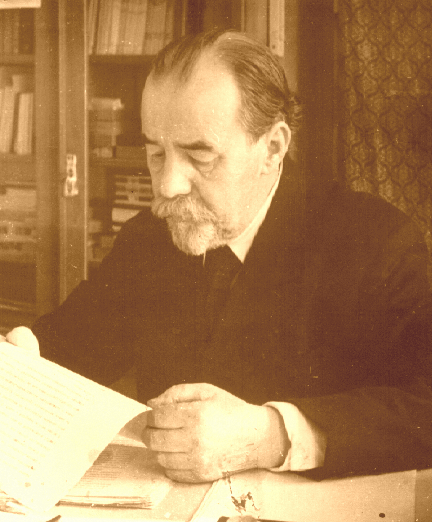 G.A.Tikhov in his working cabinet
G.A.Tikhov in his working cabinet
After training in France Tikhov is brought back into Moscow, where he has got a degree of magister, and in 1906 he begin his permanent work in Pulkovo observatory near St.-Petersburg on the advice and inviting one of the astrospectroscopy founders A.A.Belopolsky. A circle of Tikhov's astrophysical studies in Pulkovo was very broad, beginning from the observations of different optical phenomenas in terrestrial atmosphere, observations of the planets, and finishing by photometric studies of the stars and so named Kapteyn's squares - selected sky areas, where the physical properties of stars were determined to draw a conclusion eventually on the structure and characteristics of the whole our Galaxy.
Interesting and original idea was offered by Tikhov and named as a method of feathering spectrograph. Most of glass lenses show known effect of chromatic abberration and the rays of different wavelengths on photographic image of the stars do not be going to in one point, but form a round halo around the central spot. Thus, if a special ring-shaped diaphragm will be installed in front of the astrograph objective, the brightness distribution along the radius of such image will be different depending on star's spectral class, and even on-eye under the small experience possible to define a colour and spectral class of stars. Such method was suitable for studying an photographic plates with the big amount for weak stars.
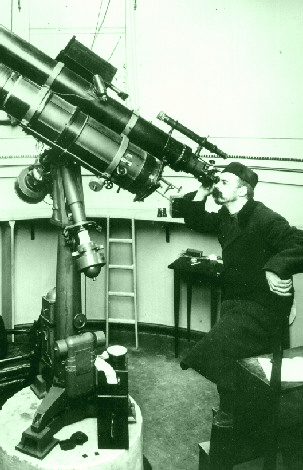 G.Tikhov at Bredikhin's astrograph in Pulkovo
G.Tikhov at Bredikhin's astrograph in Pulkovo
A number of Tikhov's works, executed at the beginning of XX century, was directed to study the different phenomenas in terrestrial atmosphere - measurements of the blue degree and polarization of the day sky, spectrography of stars-twinklings. Tikhov created new designs of instruments for such observations and offered many original methods of studies. He developed main principles of photographic photometry that subsequently has found a reflection in chapter "Astrophotometry", published by him in first edition of Pulkovian "Course of astrophysics and stellar astronomy", which appeared in 1922. Being a call in the army in 1917, Tikhov concerned with questions of visibility of distant objects that was very important for the aerophotography, and published first in the world monograph "Improvement of photographic and visual air intelligence".
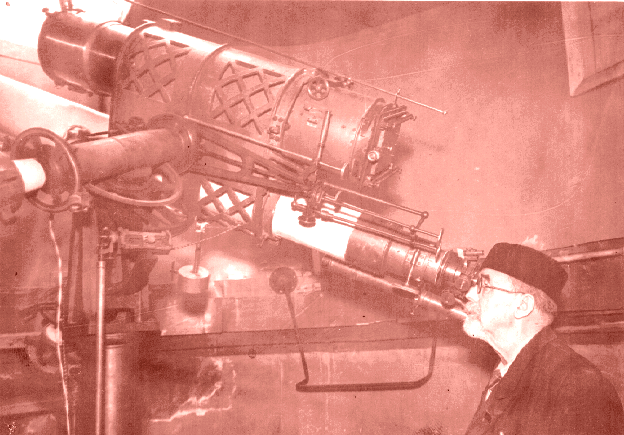
G.Tikhov at Bredikhin's astrograph in Alma-Ata
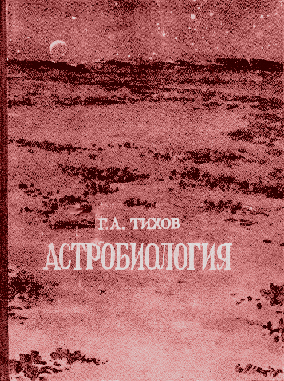 Tikhov's book "Astrobiology"
Tikhov's book "Astrobiology"
In cool and hungry 1919 Tikhov regularly lectured on the astrophysics in Petrograd university, and there were among his listeners some persons which became in the future known and famous scientists, such as V.Ambartzumian, N.Kozyrev, V.Tzesevich, V.Nikonov. Important role in the development of planetary studies have played the using of colour filters for planetary observations as was offered by Tikhov to increase a visible contrast of the images. In 1909 and later this technique was used by him for successful photography of Mars with 30-inch refractor at Pulkovo observatory. In that time the hypothesis about martian "maria" as the regions covered by vegetation was believed as very probable version, and there were done many attempts to find in the spectrum of Mars the absorption band of chlorophyll, which is characteristic for terrestrial plants.
In following years Tikhov continued the observations of the planets, taking the photographs through different filters and synthesizing then their colour images. In general, the list of Tikhov's publications belongs more than 230 on the most different questions of astrophysics, atmospheric optics, and more later about astrobotany and astrobiology. In 1927 G.A.Tikhov was elected as the associate (corresponding) member of the USSR Academy of sciences . In 1941 , in spite of the beginned war, the planned expeditions of number of astronomers from Moscow and Leningrad to Alma-Ata for the observations of total solar eclipse 21 September were realised. Alma-Ata became practically a place of evacuation for many scientists, workmans of art, some enterprises from western parts of Soviet Union. After the war not all astronomers came back to former places of work. G.A.Tikhov also stayed to work in Alma-Ata and with other scientists became a founder of Academy of sciences of Kazakhstan and one of first its academicians.
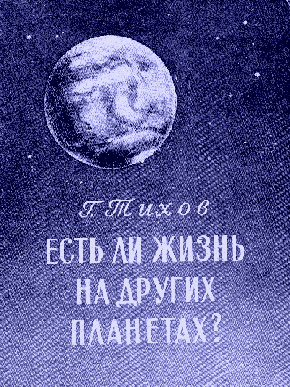 Tikhov's book "Is there the life on other planets?"
Tikhov's book "Is there the life on other planets?"
Thanks to the efforts of academicians G.A.Tikhov and V.G.Fessenkov, supported by the first president of Academy of sciences KazSSR K.I.Satpayev, the astrophysics has appeared in Kazakhstan and become to develop very actively. There was created serious observational base for different topics of astronomical and astrophysical observations. For the development of studies on the forecasting of possibility of the life existance on other solar system planets Academy of sciences KazSSR organized Sector of astrobotany, headed by Tikhov. Tikhov's observatory was equipped by Bredikhin's astrograph, which was brought from Pulkovo, and later - by 20-cm Maksutov meniscus telescope, suitable for expeditionary work and intensively used for photographic and spectral observations of the Moon and planets. It was used also in 1959-1961 and later in 70-th for astroclymatic observations in the search of the place for new observatory. In1964 (unfortunately already after Tikhov's death) new 70-cm telescope, ordered by Tikhov and designed specially for planetary observations, has appeared. It was placed on the mountain observatory of Astrophysical institute and used for many continued observations.
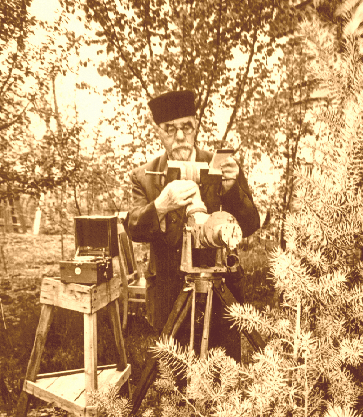 G.Tikhov is taking the spectra of plants
G.Tikhov is taking the spectra of plants
Scientific employees of Sector of astrobotany, young graduate students - biologists and physicists executed a big volume of studies, directed on the study of optical characteristics of plants and vegetable landscapes, including expeditionary works in regions with extreme climatic conditions (on Pamirs high mountains, in subarctic tundra). Primary task of these studies consisted in that to find particularities of vegetable organisms, witnessing on their adaptability to hard conditions as low temperatures, the oxygen deficiency. They have received the evidences on that under low temperatures the chlorophyll absorption band becomes more extended or disappears completely. This has served an argument in favour of existance of the plants on Mars, in spite of the absence of the chlorofill absorption in the maria spectrum of Mars. Tikhov proposed a hypothesis that plants can adapt to hard climatic conditions, changing their own optical characteristics and enlarging (or reducing) their absorption of solar radiation. Tikhov was convinced enemy of geocentrism in scientific prospecting, and insisted that life - much more wide-spread phenomena in the Universe, than it is believed by the sceptics, supporters of the uniqueness terrestrial conditions for the development of alive organisms.
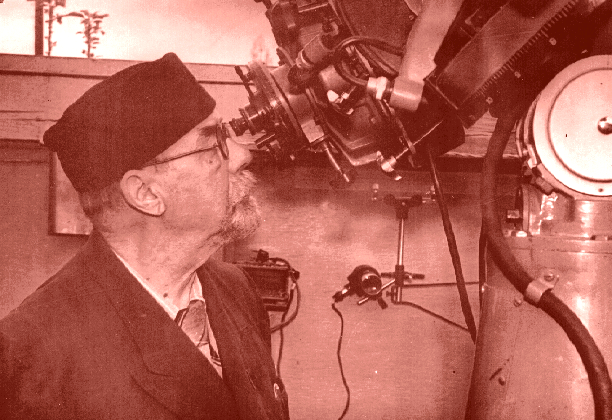
G.Tikhov at Maksutov telescope in 1957
Alongside with astrobotany studies the graduate students and employees-astronomers fulfilled a number of astrophysical observations: photometry and spectrophotometry of the Moon and planets, nonstationary and magnetic stars, comets and asteroids. Totals of executed studies were published in several volumes of Proceedings of the Astrobotany Sector, monographs and dissertations, in Tikhov books "Astrobotany" (1949), "Astrobiology" (1953), five-volume collection of Tikhov's papers. Many interesting information about Tikhov's life and creative work are kept in his autobiographic book "Sixty years beside the telescope"(1959) and in the book of A.K.Suslov "Gavriil Adrianovich Tikhov" (1980).
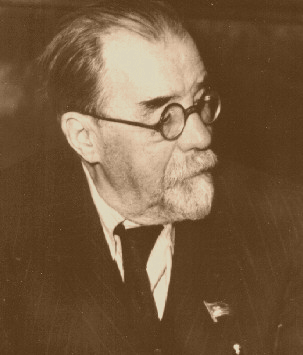 G.Tikhov in 1955
G.Tikhov in 1955
Though the space researches did not find vegetable organisms on Mars, an idea on the possibility of the life existance in conditions, powerfully distinguishing from terrestrial, did not lose its urgency. Unfortunately after Tikhov death in 1960 the Sector of astrobotany was bracked-up. Astronomical themes were moved in Astrophysical institute, headed by academician V.G.Fessenkov, where lasts until now. Astrobiological researches were soon stopped, though the problems of exobiology and space medicine in that time were already studied and developed all more in organizations actively in accordance with the development of astronautics. Situation is greatly changed in recent years, as far as in USA and partly in Russia, where serious studies in the field of astrobiology were beginned. Now the astrobiology is active again as the science on forms and development of the life in extreme conditions, distinctive both for the Earth and other planets. During the last years these studies have brought new arguments and wholly determined conclusion that the area of the life spreading on the Earth turns out to be vastly broader, than it was considered earlier. Astrobiology already considers a possibility of the life on such bodies as icy satellites of Jupiter and cometary nuclei. We can see today, how the ideas and methodologies, which were offerred by G.A.Tikhov half a century back, realized now in practice.
Back to main page
 G.A.Tikhov in his working cabinet
G.A.Tikhov in his working cabinet

 G.Tikhov is taking the spectra of plants
G.Tikhov is taking the spectra of plants
